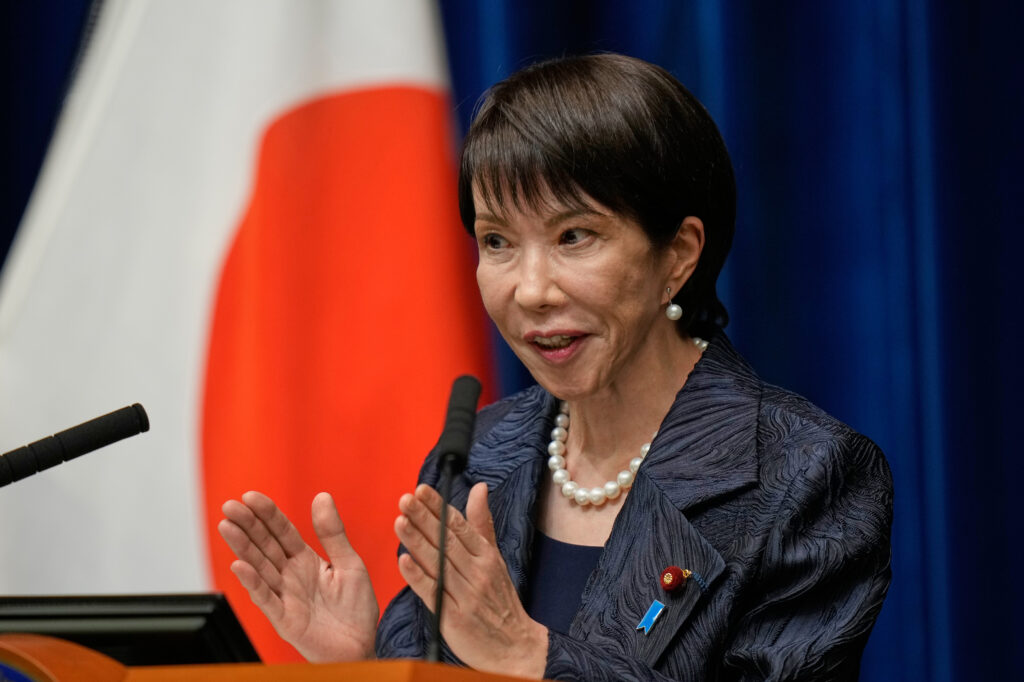Analyses / Asia-Pacific
22 October 2025
Japan: Sanae Takaichi, a “Strong Woman” Prime Minister to Reinvigorate a Nation in Crisis?

On 21 October 2025, following an agreement between her party, the Liberal Democratic Party (LDP), and the Japan Innovation Party (Ishin), Sanae Takaichi became the first woman to lead a Japanese government. She succeeds Shigeru Ishiba, who had been in office for a year. However, the stability of her government—which marks a clear shift to the right—remains to be seen, as the coalition appears fragile and the LDP itself is more divided than ever between rival factions. Externally, the challenges are equally significant: establishing a relationship of trust with the American ally, whose support is crucial, at a time when Japan faces a threatening triumvirate of dictators—China, Russia and North Korea—at its doorstep.
An analysis by Marianne Péron-Doise, Senior Research Fellow at IRIS, Co-Head of the Asia-Pacific Programme and Director of the Indo-Pacific Geopolitical Observatory.
A contrasting portrait of a “Japanese Iron Lady” but a fragile majority
Known for her conservative positions and historical revisionism, Sanae Takaichi makes no secret of her admiration for former British Prime Minister Margaret Thatcher, who appears to be her role model. Her political tenacity is undeniable: her journey has been anything but easy since her election as a Diet member for Nara in 1993 and her entry into the LDP in 1996. Unlike her rival within the LDP, Shinjiro Koizumi—the son of former Prime Minister Junichiro Koizumi (2001–2006)—she does not come from a political dynasty. Moreover, as many commentators have noted, she is a woman in a political sphere still overwhelmingly dominated by men, in a society that remains deeply traditional regarding women’s roles, including in the workforce. Yet, it seems that women’s rights are not an issue she intends to prioritise.
Politically, Sanae Takaichi positions herself as the heir to the late nationalist Prime Minister Shinzō Abe, assassinated in July 2022. Abe enjoyed exceptional longevity in office (2012–2020), which allowed him to engage in vigorous diplomacy, promoting the Indo-Pacific concept and revitalising the QUAD (the quadrilateral security dialogue between the United States, India, Australia and Japan). The current Prime Minister does not enjoy such favourable domestic circumstances. The LDP, the ruling party that had dominated post-war Japanese politics almost without interruption, has been weakened and discredited by a series of scandals. This cost it its parliamentary majority in the July 2025 general elections. Furthermore, its alliance with the centrist Komeito Party, established in 1999, has collapsed. Komeito, calling for greater transparency in political financing, was likely unsettled by Takaichi’s staunchly nationalist stance.
Through laborious negotiations with the Japan Innovation Party—a reformist centre-right movement based in Osaka—Takaichi managed to secure a coalition agreement on 20 October. Yet, this alliance remains fragile, with the opposition, composed of the Constitutional Democratic Party and the Democratic Party for the People, ready to pounce. The government has lost its majority in both houses of parliament, holding only 231 seats in the lower house (196 for the LDP and 35 for Ishin)—three short of a majority—while the opposition holds 175 seats.
A domestic agenda marked by coalition divisions
The two coalition partners, the LDP and Ishin, have agreed to reform social security, relaunch nuclear energy, and address Japan’s declining birth rate, as demographic collapse and population ageing increasingly weigh on the country’s future. The Prime Minister has also pledged to fight rising prices—a major concern for the Japanese public, particularly the unprecedented surge in rice prices—and to tighten immigration controls. Immigration has become a central issue in Japanese politics, illustrated by the breakthrough in the July 2025 upper house elections of the populist Sanseito Party, whose slogan is “Japan for the Japanese”. It now holds 14 seats in the upper chamber.
Whether Takaichi will be able to implement her agenda remains uncertain, as does the scope of concessions granted to the Innovation Party. Ishin advocates for greater regional autonomy, a reduction in the number of Diet members and government ministers, and cuts in taxes and social security costs—positions that contrast sharply with Takaichi’s policy line, which emphasises fiscal expansion, financed if necessary through deficit bonds, to revive the world’s fourth-largest economy.
Ishin also supports stricter limits on foreign labour, arguing that Japan should boost national productivity through digitalisation and regional revitalisation. Until now, the LDP has tended to encourage the presence of foreign workers to offset labour shortages in agriculture, manufacturing and healthcare.
Finally, both parties share growing concern over foreign ownership of strategic assets. Ishin has proposed tighter controls over real estate and land acquisitions by foreign buyers, implicitly targeting Chinese investors.
Major foreign policy challenges ahead
In defence policy, Ishin’s presence in government may also have an impact. Until now, Komeito’s role in coalition governments with the LDP had been a moderating one. Pacifist in orientation, Komeito has long resisted major military expansion and disapproved of visits to Tokyo’s Yasukuni Shrine, where Japan’s war dead—including convicted war criminals—are honoured. The party has also sought to maintain dialogue with China, a goal shared by prominent opposition figure Yukio Hatoyama, former Prime Minister (2009–2010) and member of the Constitutional Democratic Party.
By contrast, the Innovation Party emphasises deterrence and military preparedness, advocating a “proactive defence” policy similar to that of Shinzō Abe. In line with the LDP, Ishin supports raising defence spending to 2% of GDP—a goal Japan is close to achieving. In foreign and defence policy, the coalition is thus likely to strengthen ties with the United States and regional partners while taking a firmer stance towards China and North Korea.
Lacking real diplomatic experience, Sanae Takaichi now faces key international meetings: with US President Donald Trump in Tokyo on 27 October 2025, at the ASEAN Summit in Malaysia on 26 October, and at the Asia-Pacific Economic Cooperation (APEC) Forum in South Korea from 28 to 31 October. She may also meet South Korean President Lee Jae-myung, and possibly Chinese leader Xi Jinping.
Ahead of these meetings, Takaichi chose not to attend the autumn festival at Yasukuni Shrine, still seen by China and South Korea as a symbol of Japanese militarism. This decision likely signals an attempt at conciliation with two important neighbours—an indication of a certain diplomatic pragmatism. The Chinese Foreign Ministry, perhaps reassured by her gesture but wary of her previous statements in support of Taiwan, expressed hope for “mutually beneficial relations” with Tokyo. As for South Korea, the rapprochement initiated by Shigeru Ishiba is expected to continue, maintaining cooperation through the trilateral Japan–South Korea–United States format established at the Camp David Summit in August 2023 under the Biden administration.
Nonetheless, potential points of tension remain with Japan’s main ally, the United States. These include the still-unclear terms of the USD 500 billion in investments secured by President Trump during negotiations over the bilateral tariff agreement. Trump also wants Tokyo to halt imports of Russian energy and further increase defence spending.
For now, Takaichi supports strengthening Japan’s Self-Defence Forces (SDF), which are undergoing a five-year modernisation programme. The defence budget is set to double to reach 2% of GDP by 2027. However, President Trump could soon demand that Japan raise its military expenditure to 5% of GDP, in line with NATO targets, and purchase more American weapons.

